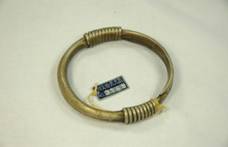TELDAP Collections
| Costumes of Taiwanese Aborigines –Decorations of the Upper Body |
|
The aboriginal people in Taiwan have a great affection for body decorations, whether they are men or women. Decorations of the upper body include head accessories, earrings, necklaces, breast ornaments, armlets, bracelets, rings, etc. The materials used primarily contain jades, shells, animal teeth and bones, hide (or fur), precious metals (silver and bronze), buttons, coins, glass beads, and flowers and plants. These accessories fully represent the aesthetics and the value of these tribal cultures. The Atayal Tribe, who are renowned for the excellence in beadwork, manufacture delicate shell beads with tridacna (fluted giant clam). These shell beads are not only decorated on long garments, but made into necklaces, both of which are ideal for dowry and transaction media. There are also various styles of earrings. People of the Ami Tribe make earrings, necklaces and breast ornaments by grinding shells. Both males and females of this tribe think highly of crest and head accessories, while males of the Tsou Tribe are experts in tanning leather into clothes which they wear. They also wear armlets made of teeth from wild boars and human hair, as well as earrings of ground shells. Hanging down from their leather hats are long feathers of pheasants. In the Paiwan and the Rukai Tribes, ornaments are, more often than not, worn by the nobles. Glass beads and cowrie-beaded strings are in particular restricted to the usage of their nobles only. Moreover, the patterns of their clothes are extremely intricate and exquisite. Feathers of eagles appear to be generally decorated on their head accessories worn by both males and females. The head accessories belonging to those among the chieftain rank are decorated with feathers of male eagles, symbolizing the highest glory. Some tribal habitants in Butsul Paiwan and Rukai Tribe wear lilies to represent the virtues of chastity and prowess of hunting. The Tao Tribe (also called the Yami Tribe) living on the Orchid Island make delicate ornaments with their own hands, among which there exists explicit distinctness between those of males and females. When it is time for them to dress up, Tao males wear silver helmets, breast ornaments dangling a slice of golden foil and silver bracelets, while the females wear hair accessories decorated with buttons, strings of agate beads, or necklaces made of nautilus.
內容發展分項計畫 人類學主題小組
Collections of Taiwanese Aborigines—Decorations of the Upper Body
Former title: Bracelet Title in English: bracelet
Title in vernacular: yoyora
Former title: Bracelet
Title in English: silver bracelet
Title in vernacular: pacinoken
Former title: Bracelet
Formal Title: Silver bracelet
Title in English: Silver bracelet
Title in vernacular: kaljate
|














